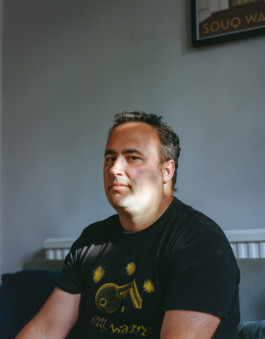Matt: “You know that bit at the start of disaster movie when there’s someone who knows that the thing is coming but the rest of the world doesn’t seem to know yet”


listen:
Photography: Myah Jeffers
Audio Producer: Rob Eagle
read:
At the peak of lockdown, I kind of all of a sudden had lots more WhatsApp groups. And the one with my family, we kind of decided to do this thing where we would kind of play an intro on the piano - if you could work out or who could guess what’s the intro? People didn’t have as much to talk about, because there was only one thing on the news. No one was doing anything, no one was going anywhere. I guess it was a way of kind of connecting, kind of having something to say with people.
My name is Matt Tagney, and I am the Director of the Long Term Plan Implementation for NHS England and improvement. So I spend quite a lot of time thinking about the future of health in the NHS, and how we can make things better, usually looking over kind of the next three, four or five years.
You know, at the start of disaster movies, where there’s someone or a group of people who know that the thing is coming, but the rest of the world doesn’t seem to yet. So there’s that scene where they’re like walking through a city. Quite often there’s like a radio in the background, that’s saying ‘And today, and…’ And there was a bit in March, where we were thinking about, you know, how do we get enough doctors and nurses to the right place to make sure we can deal with this peak that we didn’t know how big it was gonna be. And then you’d go out and you’d just take a walk around the, you know, the block or go and get a sandwich or something. And the rest of the world was carrying on as normal. It was a really weird and eerie feeling, actually.
Because all of the strategic planning – the planning for the long–term – had kind of been paused to allow us to focus on this, I went to lead the workforce cell, which was, at that point, focused on making sure we had the right numbers of doctors and nurses in the right place – and other clinicians as well – to deal with the wave of Coronavirus patients that we were expecting to see at that point.
And it was things like, you know – when we when we wrote out to all of the clinicians who’d come off the medical register, or who’d stopped working in the NHS in the last couple of years and asked them if they would come back and kind of put in place arrangements so they could come back easily. And we got like 40,000 people who said that they wanted to come back and help, which was fantastic. But then when that happens, you then have the issue of: how do you take 40,000 people and match them to a role that they can do in a place that needs them, that they have the skills and the competence for, and how do you look after them and make sure they kind of get the right induction and the right protection as they come back?
And that was of course logistically a huge task. And so I think we went from a team of like, you know, 10 people processing these to a team of hundreds of people having to process these in a week or two weeks. And the people who did that - you know, it was a tremendous, huge effort. As soon as we identified there was a thing that needed to be done, you know, amazing things will happen in short times.
And then and then later on in March, the numbers of people who’d had Coronavirus or were getting the virus started to go up. And then you were starting to see this kind of exponential growth. So you know, the numbers double over a period of time. At that point, I didn’t know when it was going to stop. And so if you think about the role I was in – we’re just like, have we got enough doctors and nurses, are we going to have enough doctors and nurses in a week in two weeks? If you don’t know when the peak is going to be you can just see the numbers going up and the line getting steeper, it’s really hard to say if you’re going to have enough, and that felt really stressful. Because at that, at that point, it felt like everything I did had the potential to make a really big difference. That if I didn’t do something and as a result of that even one person didn’t get through this process or one person wasn’t able to go to work that day or one person was off sick for longer than they needed to be, then actually that could be a really critical hole, that could be somebody not getting care. And I’ve never felt kind of as stressed - or kind of as worried - as at that point. And it was kind of almost like a physical kind of tightness in my chest, worrying about ‘I am I doing everything I can, are we going to have enough people to deal with this?’. And this was kind of the hardest thing I’ve had to do in my career so far.
Because I was a key worker, our kids went to school. We sent them; they went in sort of two days a week during the pandemic. So we had it, I think, easier than some people certainly. But definitely, we had absolutely had the experience of two of us working from home with kids who were supposed to be doing homeschooling, and the challenges of - you know, particularly with our younger one, who’s five, who needs a little bit more support and help to kind of do the activities and tasks - how you kind of juggle that without kind of resorting to kids watching everything on Netflix in a day.
One of the positive bits, I guess, was that we kind of realised just how much we’ve got around us, how lucky we are, you know, to have quite a lot of green space around us. Our kids got an awful lot better at riding bikes, and we used to go on like long bike rides and walks with them trying to get out of the house a bit.
As we kind of moved into April, we started to get models and we could see what the top of the mountain might be and where we might need to get to, and therefore kind of have a bit more confidence that what we were doing was enough. But even then you don’t know. You don’t know, you’re kind of waiting for the peak to happen. And you’re kind of hoping it’s gonna happen at the point that the model says it is and, as that month went on, it just became more of… there was just one thing that we had to do. And that was make sure that we had enough people and enough resources to deal with the peak of Coronavirus that we knew was coming. And, you know, we were saying actually you don’t you don’t need to do this; there are things we’re stopping, there are things that we don’t have to think about. And it was kind of a real singularity of focus.
It was later on in April, where I think we could see there was a definite kind of downward trend in the number of patients that we had in intensive care. But then at that point, you know, the rest of the world starts to come crashing back in. And then we start to think about all the things that we’ve stopped that we haven’t done, all the people who haven’t gone to A&E because they got told to stay at home and they were staying at home. And all the people who might have had minor strokes and didn’t go to A&E. All the people who, if it hadn’t been for Coronavirus, would have gone to their GP about a lump or something that could have turned out to be something serious. That was when it started to feel like life got complicated again in some ways: how do we get back to a place where we have an NHS that’s thinking about everything and everything again, and not just really focusing on Coronavirus.
Usually in the kind of jobs we do, there’s kind of a really big gap between, ‘Oh, we should do this policy’ and ‘Maybe if we put this money here it’ll make a difference’ and then it’s only usually a couple of years later you can look back and say, oh yeah, that kind of… that made the difference, made the difference.
Whereas with this it was kind of immediate, it was all so fast-paced that, you know, you do something one day and then the next week it will be happening – or even the next day it would be happening in the NHS.
And that kind of immediacy was, on one level, satisfying.
But only in retrospect, if I’m honest.
An Empathy Museum project made with the support of NHS England and NHS Improvement, The Health Foundation, and Arts Council England